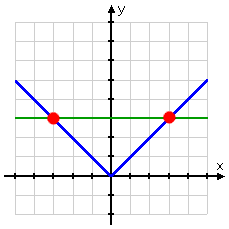Solving Simpler Absolute-Value Equations
Purplemath
When we take the absolute value of a number, we always end up with a positive number (or zero). Whether the input was positive or negative (or zero), the output is always positive (or zero). For instance, | 3 | = 3, and | −3 | = 3 also.
This property — that both the positive and the negative become positive — makes solving absolute-value equations a little tricky. But once you learn the "trick", they're not so bad. Let's start with something simple:
Content Continues Below
-
Solve | x | = 3
I've pretty much already solved this, in my discussion above:
| 3 | = 3
| −3 | = 3
So then x must be equal to 3 or equal to −3.
But how am I supposed to solve this if I don't already know the answer? I will use the positive / negative property of the absolute value to split the equation into two cases, and I will use the fact that the "minus" sign in the negative case indicates "the opposite sign", not "a negative number".
For example, if I have x = −6, then "−x " indicates "the opposite of x" or, in this case, −(−6) = +6, a positive number. The "minus" sign in "−x" just indicates that I am changing the sign on x. It does not indicate a negative number. This distinction is crucial!
Whatever the value of x might be, taking the absolute value of x makes it positive. Since x might originally have been positive and might originally have been negative, I must acknowledge this fact when I remove the absolute-value bars. I do this by splitting the equation into two cases. For this exercise, these cases are as follows:
a. If the value of x was non-negative (that is, if it was positive or zero) to start with, then I can bring that value out of the absolute-value bars without changing its sign, giving me the equation x = 3.
b. If the value of x was negative to start with, then I can bring that value out of the absolute-value bars by changing the sign on x, giving me the equation −x = 3, which solves as x = −3.
Then my solution is
x = ±3
Content Continues Below
We can, by the way, verify the above solution graphically. When we attempt to solve the absolute-value equation | x | = 3, we are, in effect, setting two line equations equal to each other and finding where they cross. For instance:

In the above, I've plotted the graph of y1 = | x | (being the blue line that looks like a "V") and y2 = 3 (being the green horizontal line). These two graphs cross at x = −3 and at x = +3 (being the two red dots).
Affiliate
If you're wanting to check your answers on a test (before you hand it in), it can be helpful to plug each side of the original absolute-value equation into your calculator as their own functions; then ask the calculator for the intersection points.
Of course, any solution can also be verified by plugging it back into the original exercise, and confirming that the left-hand side (LHS) of the equation simplifies to the same value as does the right-hand side (RHS) of the equation. For the equation above, here's my check:
x = −3
LHS: | x | = | −3 |
= 3 = RHS
x = +3
LHS: | x | = | +3 |
= 3 = RHS
If you're ever in doubt about your solution to an equation, try graphing or else try plugging your solution back into the original question. Checking your work is always okay!
Affiliate
The step in the above, where the absolute-value equation was restated in two forms, one with a "plus" and one with a "minus", gives us a handy way to simplify things: When we have isolated the absolute value and go to take off the bars, we can split the equation into two cases; we will signify these cases by placing a "minus" on the opposite side of the equation (for one case) and a "plus" on the opposite side (for the other). Here's how this works:
-
Solve | x + 2 | = 7, and check your solution(s).
Advertisement
The absolute value is isolated on the left-hand side of the equation, so it's already set up for me to split the equation into two cases. To clear the absolute-value bars, I must split the equation into its two possible two cases, one each for if the contents of the absolute-value bars (that is, if the "argument" of the absolute value) is negative and if it's non-negative (that is, if it's positive or zero). To do this, I create two new equations, where the only difference between then is the sign on the right-hand side. First, I'll do the "minus" case:
x + 2 = −7
x + 2 = −7
x = −9
Now I'll do the non-negative case, where I can just drop the bars and solve:
x + 2 = 7
x = 5
Now I need to check my solutions. I'll do this by plugging them back into the original equation, since the grader can't see me checking plots on my graphing calculator.
x = −9:
LHS: |(−9) + 2|
= |−7| = 7 = RHS
x = 5:
LHS: |(5) + 2|
= |7| = 7 = RHS
Both solutions check, so my answer is:
x = −9, 5
Affiliate
-
Solve | 2x − 3 | − 4 = 3
First, I'll isolate the absolute-value part of the equation; that is, I'll get the absolute-value expression by itself on one side of the "equals" sign, with everything else on the other side:
| 2x − 3 | − 4 = 3
| 2x − 3 | = 7
Now I'll clear the absolute-value bars by splitting the equation into its two cases, one for each sign on the argument. First I'll do the negative case:
2x − 3 = −7
2x = −4
x = −2
And then I'll do the non-negative case:
2x − 3 = 7
2x = 10
x = 5
The exercise doesn't tell me to check, so I won't. (But, if I'd wanted to, I could have plugged "abs(2X−3)−4" and "3" into my calculator (as Y1 and Y2, respectively), and seen that the intersection points were at my x-values.) My answer is:
x = −2, 5
URL: https://www.purplemath.com/modules/solveabs.htm
Select a Course Below
Standardized Test Prep
Homeschool Math
© 2024 Purplemath, Inc. All right reserved. Web Design by ![]()



